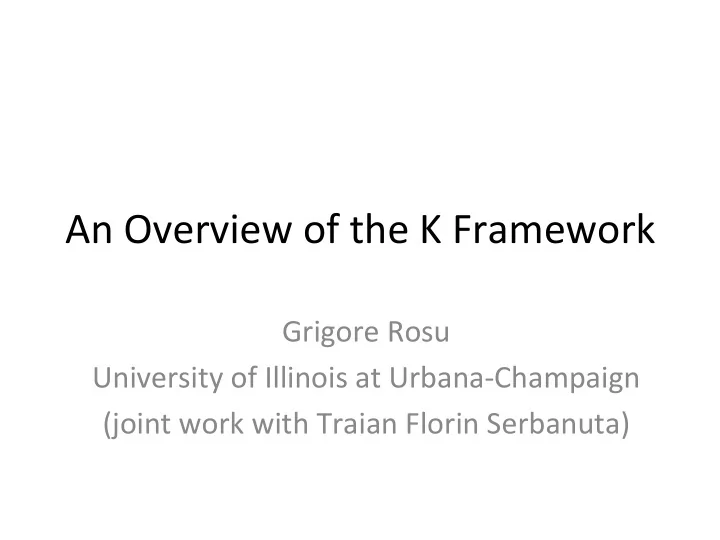

An Overview of the K Framework Grigore Rosu University of Illinois at Urbana‐Champaign (joint work with Traian Florin Serbanuta)
Challenges in Programming Language Design / SemanIcs / Analysis • Programming languages are conInuously born, updated and extended – C#, CIL; Java memory model, Scheme R6RS, C1X – Concurrency is the norm, not the excepIon • Executable specificaIons could help – Design and maintain mathemaIcal definiIons – Easily test/analyze language updates/extensions – Explore/Abstract non‐determinisIc execuIons
K Project • Started in 2003, moIvated mainly by teaching programming languages and noIcing that the exisIng semanIc frameworks have limitaIons • Project thesis: – RewriIng gives an appropriate environment to formally define the semanIcs of real‐life programming languages and to test and analyze programs wri[en in those languages.
Overview • RewriIng logic semanIcs project – How it all started ... • K framework – K definiIonal style – K concurrent rewriIng • Example – Challenge language
RewriIng Logic SemanIcs Project • RewriIng Logic (RWL) – Meseguer 1992 • RewriIng Logic SemanIcs (RLS) Project • Advance the use of rewriIng logic for defining programming languages, and for execuIng and analyzing programs wri[en in them • ParIcipants (probably incomplete list): Wolfgang Ahrendt, Musab Al‐Turki, Marcelo d’Amorim, Irina M. Asavoae, Mihai Asavoae, Eyvind W. – Axelsen, ChrisIano Braga, Illiano Cervesato, Fabricio Chalub, Feng Chen, Manuel Clavel, Chucky Ellison, Azadeh Farzan, Alejandra Garrido, Mark Hills, Michael Ilseman, Einar Broch Johnsen, Ralph Johnson, Michael Katelman, LaurenIu Leustean, Dorel Lucanu, Narciso Mard‐Oliet, Patrick Meredith, Jose Meseguer, Elena Naum, Olaf Owe, Stefan Reich, Grigore Rosu, Andreas Roth, Juan Santa‐Cruz, Ralf Sasse, Wolfram Schulte, Koushik Sen, Andrei S , tefanescu, Mark‐Oliver Stehr, Carolyn Talco[, Prasanna ThaI, Traian Serbanuta, Ram Prasad Venkatesan, Alberto Verdejo
Why is RewriIng Logic Good for Programming Languages ? • Executability – Language definiIons turn into interpreters • Concurrency – The norm rather than the excepIon • EquaIonal abstracIon – Collapse state space through equaIons • Generic tools (built around Maude) – ExecuIon, tracing, debugging, state space search, model checker, inducIve theorem prover
Guidelines for Defining Programming Languages in RWL • Represent program state as configuraIon term • Represent computaIonal steps as rewrite rules • Represent structural changes as equa-ons • These associate to any given configuraIon a transi-on system – In parIcular, it associates semanIcs to programs • ResulIng transiIon systems are amenable to exploraIon, search and model checking • Great, but it does not tell us how to do it
ConvenIonal semanIc frameworks become RWL definiIonal methodologies • This allows to define a language using one’s favorite semanIc style, and then to execute, explore or model check it using RWL
ConvenIonal semanIc frameworks become RWL definiIonal methodologies Many authors contributed to this diagram, including all the abovemenIoned. See [Serbanuta, Rosu, Meseguer 2007 – Inf. & Comp.] for a recent survey. • This allows to define a language using one’s favorite semanIc style, and then to execute, explore or model check it using RWL
ExisIng SemanIcs Frameworks, From a Unified PerspecIve • The unified view of semanIc frameworks within RWL also allows to be[er examine them and understand their limitaIons • For example, can exisIng styles define real programming languages on a regular basis, as opposed to only toy languages ? – No, but their combined strengths might
Shortcomings of ExisIng Frameworks • Hard to deal with control (except evaluaIon contexts) – halt, break/conInue, excepIons, callcc • Non‐modular (except Modular SOS) – Adding new features require changing unrelated rules • Lack of semanIcs for true concurrency (except CHAM) – Big‐Step captures only all possible results of computaIon – ReducIon approaches only give interleaving semanIcs • Tedious to find next redex (except evaluaIon contexts) – One has to write the same descent rules for each construct • Inefficient as interpreters (except for Big‐Step SOS)
Towards an Ideal PL DefiniIonal Framework • Our iniIal goal was to search for an ideal language definiIonal framework within RWL – At least as expressive as evaluaIon contexts – At least as modular as Modular SOS – At least as concurrent as the CHAM
Recommend
More recommend